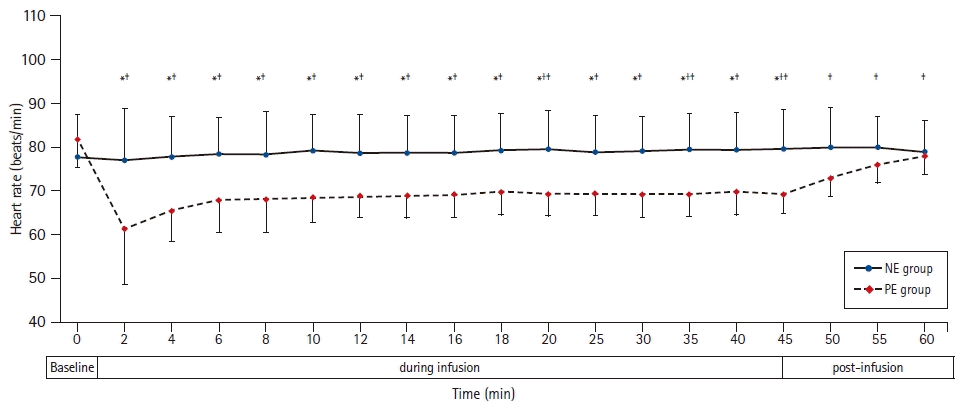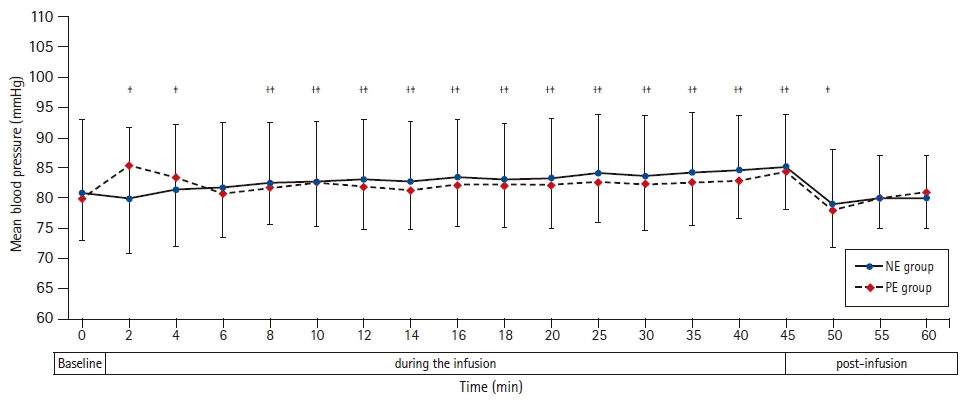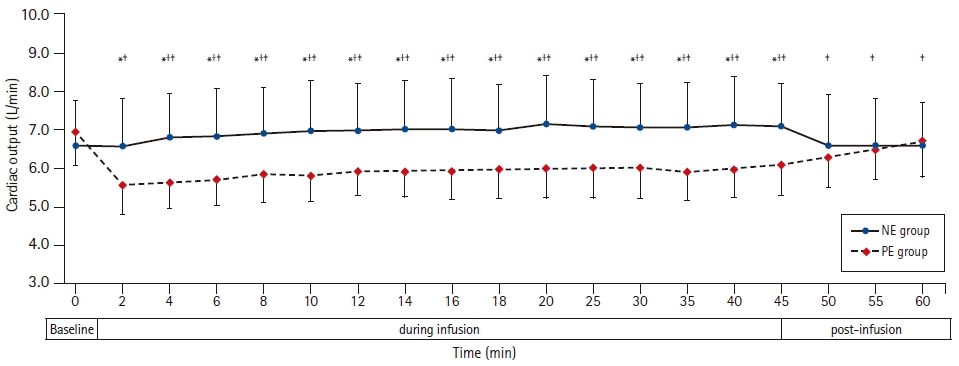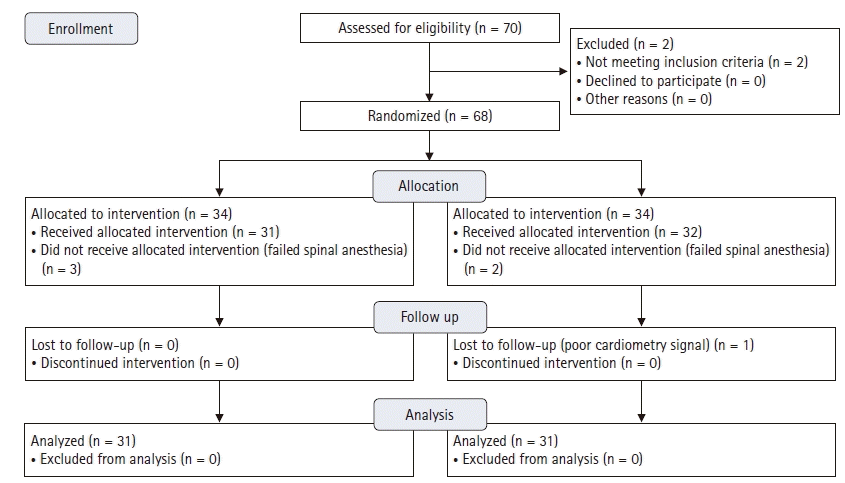1. Ferré F, Marty P, Bruneteau L, Merlet V, Bataille B, Ferrier A, et al. Prophylactic phenylephrine infusion for the prevention of hypotension after spinal anesthesia in the elderly: a randomized controlled clinical trial. J Clin Anesth. 2016; 35:99–106.

2. White SM, Moppett IK, Griffiths R, Johansen A, Wakeman R, Boulton C, et al. Secondary analysis of outcomes after 11,085 hip fracture operations from the prospective UK Anaesthesia Sprint Audit of Practice (ASAP-2). Anaesthesia. 2016; 71:506–14.

3. Sessler DI, Bloomstone JA, Aronson S, Berry C, Gan TJ, Kellum JA, et al. Perioperative Quality Initiative consensus statement on intraoperative blood pressure, risk and outcomes for elective surgery. Br J Anaesth. 2019; 122:563–74.

4. Dobson PM, Caldicott LD, Gerrish SP, Cole JR, Channer KS. Changes in haemodynamic variables during transurethral resection of the prostate: comparison of general and spinal anaesthesia. Br J Anaesth. 1994; 72:267–71.
5. Gelman S. Venous function and central venous pressure: a physiologic story. Anesthesiology. 2008; 108:735–48.
6. Hofhuizen C, Lemson J, Snoeck M, Scheffer GJ. Spinal anesthesia-induced hypotension is caused by a decrease in stroke volume in elderly patients. Local Reg Anesth. 2019; 12:19–26.
7. Kinsella SM, Carvalho B, Dyer RA, Fernando R, McDonnell N, Mercier FJ, et al. International consensus statement on the management of hypotension with vasopressors during caesarean section under spinal anaesthesia. Anaesthesia. 2018; 73:71–92.

8. Ngan Kee WD, Lee SW, Ng FF, Tan PE, Khaw KS. Randomized double-blinded comparison of norepinephrine and phenylephrine for maintenance of blood pressure during spinal Anesthesia for cesarean delivery. Anesthesiology. 2015; 122:736–45.

9. Jakobsson J, Kalman SH, Lindeberg-Lindvet M, Bartha E. Is postspinal hypotension a sign of impaired cardiac performance in the elderly? An observational mechanistic study. Br J Anaesth. 2017; 119:1178–85.

10. Vallée F, Passouant O, Le Gall A, Joachim J, Mateo J, Mebazaa A, et al. Norepinephrine reduces arterial compliance less than phenylephrine when treating general anesthesia-induced arterial hypotension. Acta Anaesthesiol Scand. 2017; 61:590–600.

11. Sharkey AM, Siddiqui N, Downey K, Ye XY, Guevara J, Carvalho JC. Comparison of intermittent intravenous boluses of phenylephrine and norepinephrine to prevent and treat spinal-induced hypotension in cesarean deliveries: randomized controlled trial. Anesth Analg. 2019; 129:1312–8.
12. Hasanin AM, Amin SM, Agiza NA, Elsayed MK, Refaat S, Hussein HA, et al. Norepinephrine infusion for preventing postspinal anesthesia hypotension during cesarean delivery: a randomized dose-finding trial. Anesthesiology. 2019; 130:55–62.
13. Hasanin A. Fluid responsiveness in acute circulatory failure. J Intensive Care. 2015; 3:50.

14. Hasanin A, Amin S, Refaat S, Habib S, Zayed M, Abdelwahab Y, et al. Norepinephrine versus phenylephrine infusion for prophylaxis against post-spinal anaesthesia hypotension during elective caesarean delivery: a randomised controlled trial. Anaesth Crit Care Pain Med. 2019; 38:601–7.

15. Stewart A, Fernando R, McDonald S, Hignett R, Jones T, Columb M. The dose-dependent effects of phenylephrine for elective cesarean delivery under spinal anesthesia. Anesth Analg. 2010; 111:1230–7.

16. Goertz AW, Schmidt M, Seefelder C, Lindner KH, Georgieff M. The effect of phenylephrine bolus administration on left ventricular function during isoflurane-induced hypotension. Anesth Analg. 1993; 77:227–31.

17. Allen TK, George RB, White WD, Muir HA, Habib AS. A double-blind, placebo-controlled trial of four fixed rate infusion regimens of phenylephrine for hemodynamic support during spinal anesthesia for cesarean delivery. Anesth Analg. 2010; 111:1221–9.

18. Xiao F, Shen B, Xu WP, Feng Y, Ngan Kee WD, Chen XZ. Dose-response study of 4 weight-based phenylephrine infusion regimens for preventing hypotension during cesarean delivery under combined spinal-epidural anesthesia. Anesth Analg. 2020; 130:187–93.

19. Ngan Kee WD. A Random-allocation graded dose-response study of norepinephrine and phenylephrine for treating hypotension during spinal anesthesia for cesarean delivery. Anesthesiology. 2017; 127:934–41.

20. Bartha E, Arfwedson C, Imnell A, Fernlund ME, Andersson LE, Kalman S. Randomized controlled trial of goal-directed haemodynamic treatment in patients with proximal femoral fracture. Br J Anaesth. 2013; 110:545–53.

21. Žunić M, Krčevski Škvarč N, Kamenik M. The influence of the infusion of ephedrine and phenylephrine on the hemodynamic stability after subarachnoid anesthesia in senior adults - a controlled randomized trial. BMC Anesthesiol. 2019; 19:207.

22. Kinsella SM, Carvalho B, Dyer RA, Fernando R, McDonnell N, Mercier FJ, et al. International consensus statement on the management of hypotension with vasopressors during caesarean section under spinal anaesthesia. Anaesthesia. 2018; 73:71–92.

23. Dai X, Hummel SL, Salazar JB, Taffet GE, Zieman S, Schwartz JB. Cardiovascular physiology in the older adults. J Geriatr Cardiol. 2015; 12:196–201.
24. Priebe HJ. The aged cardiovascular risk patient. Br J Anaesth. 2000; 85:763–78.

25. Hasanin A, Mukhtar A, Nassar H. Perfusion indices revisited. J Intensive Care. 2017; 5:24.

26. Lairez O, Ferré F, Portet N, Marty P, Delmas C, Cognet T, et al. Cardiovascular effects of low-dose spinal anaesthesia as a function of age: an observational study using echocardiography. Anaesth Crit Care Pain Med. 2015; 34:271–6.

27. Sanders M, Servaas S, Slagt C. Accuracy and precision of non-invasive cardiac output monitoring by electrical cardiometry: a systematic review and meta-analysis. J Clin Monit Comput. 2020; 34:433–60.

28. Mazgaoker S, Ketko I, Yanovich R, Heled Y, Epstein Y. Measuring core body temperature with a non-invasive sensor. J Therm Biol. 2017; 66:17–20.

29. Hasanin A, Soryal R, Kaddah T, Raouf SA, Abdelwahab Y, Elshafaei K, et al. Hemodynamic effects of lateral tilt before and after spinal anesthesia during cesarean delivery: an observational study. BMC Anesthesiol. 2018; 18:8.

30. Fathy S, Hasanin A, Mostafa M, Ramzy E, Sarhan K, Almenesey T, et al. The benefit of adding lidocaine to ketamine during rapid sequence endotracheal intubation in patients with septic shock: a randomised controlled trial. Anaesth Crit Care Pain Med. 2021; 40:100731.








 PDF
PDF Citation
Citation Print
Print




 XML Download
XML Download